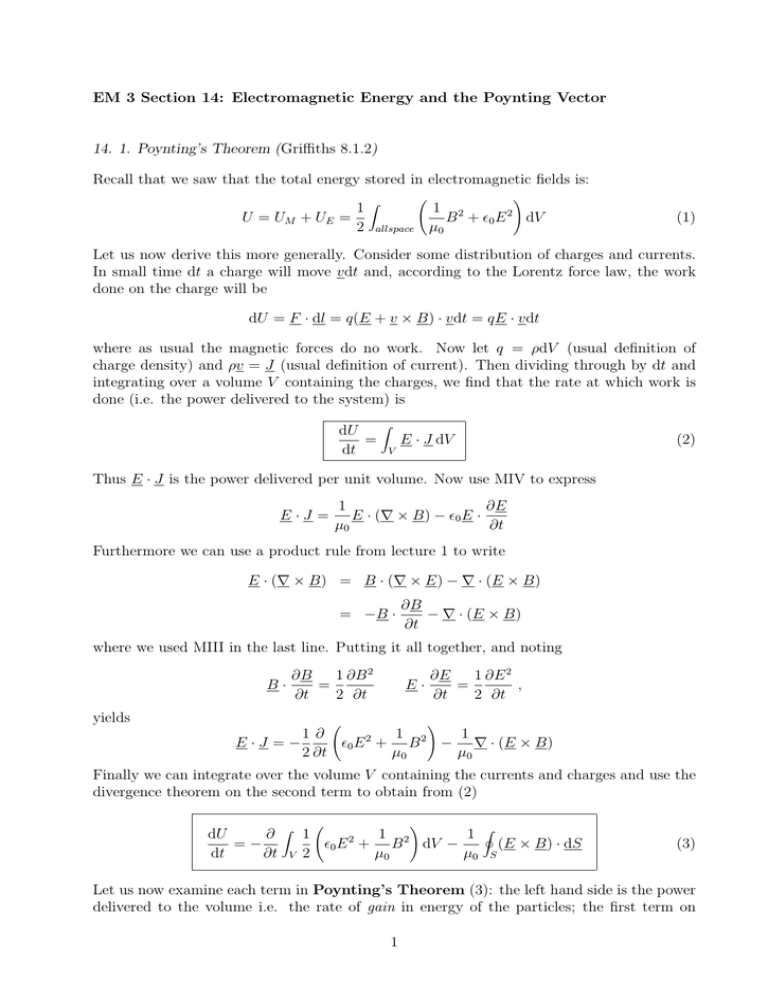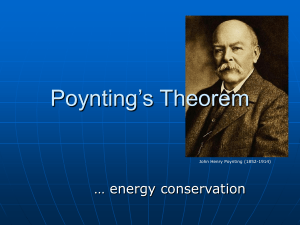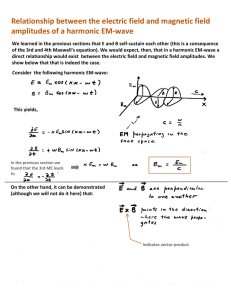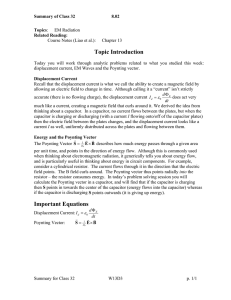EM 3 Section 14: Electromagnetic Energy and the Poynting Vector
advertisement

EM 3 Section 14: Electromagnetic Energy and the Poynting Vector 14. 1. Poynting’s Theorem (Griffiths 8.1.2) Recall that we saw that the total energy stored in electromagnetic fields is: ! U = UM 1Z 1 2 + UE = B + 0 E 2 dV 2 allspace µ0 (1) Let us now derive this more generally. Consider some distribution of charges and currents. In small time dt a charge will move vdt and, according to the Lorentz force law, the work done on the charge will be dU = F · dl = q(E + v × B) · vdt = qE · vdt where as usual the magnetic forces do no work. Now let q = ρdV (usual definition of charge density) and ρv = J (usual definition of current). Then dividing through by dt and integrating over a volume V containing the charges, we find that the rate at which work is done (i.e. the power delivered to the system) is Z dU E · J dV = dt V (2) Thus E · J is the power delivered per unit volume. Now use MIV to express E·J = 1 ∂E E · (∇ × B) − 0 E · µ0 ∂t Furthermore we can use a product rule from lecture 1 to write E · (∇ × B) = B · (∇ × E) − ∇ · (E × B) = −B · ∂B − ∇ · (E × B) ∂t where we used MIII in the last line. Putting it all together, and noting B· 1 ∂B 2 ∂B = ∂t 2 ∂t E· 1 ∂E 2 ∂E = , ∂t 2 ∂t yields ! 1∂ 1 1 E·J =− 0 E 2 + B 2 − ∇ · (E × B) 2 ∂t µ0 µ0 Finally we can integrate over the volume V containing the currents and charges and use the divergence theorem on the second term to obtain from (2) ! dU ∂ Z 1 1 2 1 I 2 =− 0 E + B dV − (E × B) · dS dt ∂t V 2 µ0 µ0 S (3) Let us now examine each term in Poynting’s Theorem (3): the left hand side is the power delivered to the volume i.e. the rate of gain in energy of the particles; the first term on 1 the right hand side is the rate of loss of electromagnetic energy stored in fields within the volume; the second term is the rate of energy transport out of the volume i.e. across the surface S. Thus Poynting’s theorem reads: energy lost by fields = energy gained by particles+ energy flow out of volume. Hence we can identify the vector S= 1 E×B µ0 (4) as the energy flux density (energy per unit area per unit time) and it is known as the Poynting vector (it ‘Poynts’ in the direction of energy transport). Also we can write Poynting’s theorem as a continuity equation for the total energy U = Uem + Umec . The left hand side of (3) is the rate of change of mechanical energy thus I d(Uem + Umec ) = − S · dA dt S (to avoid a nasty clash of notation with S as Poynting vector we use dA rather than dS as vector element of area). As usual, expressing energy as a volume over energy densities uem ,umec and using the divergence theorem on the right hand side we arrive at ∂ (uem + umec ) = −∇ · S ∂t (5) which is the continuity equation for energy density. Thus the Poynting vector represents the flow of energy in the same way that the current J represents the flow of charge. 14. 2. Energy of Electromagnetic Waves (Griffiths 9.2.3) As we saw last lecture a monochromatic plane wave in vacuo propagating in the ez direction is described by the fields: E = ex E0 cos(kz − ωt) B = ey B0 cos(kz − ωt) (6) where E0 c The total energy stored in the fields associated with the wave is: B0 = U = UE + UM 1Z = 2 V B2 + 0 E 2 dV µ0 ! √ Now since |B| = |E|/c and c = 1/ µ0 0 we see that the electric and magnetic contributions to the total energy are equal and the electromagnetic energy density is (for a linearly polarised wave) uEM = 0 E 2 = 0 E02 cos2 (kz − ωt) The Poynting vector becomes for monochromatic waves S= 1 (E × B) = c0 E02 cos2 (kz − ωt)ez = uEM cez µ0 2 Note that S is just the energy density multiplied by the velocity of the wave cez as it should be. Generally S = uEM ck̂ N.B To compute the Poynting vector it is simplest to use a real form for the fields B and E rather than a complex exponential representation. The time average of the energy density is is defined as the average over one period T of the wave 0 E02 Z T cos2 (kz − ωt)dt huEM i = T 0 0 E02 T 1 1 B02 = = 0 E02 = T 2 2 2 µ0 The energy density of an electromagnetic wave is proportional to the square of the amplitude of the electric (or magnetic) field. 14. 3. Example of discharging capacitor Consider a discharging circular parallel plate capacitor (plates area A) in a circuit with a Figure 1: Discharging capacitor in a circuit with a resistor resistor R. Ohm’s law gives Vd = or I=− dQ Q = dt RC ⇒ Q = IR C Q = Q0 e−t/RC I= Q0 −t/RC e RC Now assume a ‘quasistatic’ approximation where we treat the fields as though they were static: Q Q −t/RC E=− n̂ = − e A0 A0 We take the normal to the plates (direction of E) is n̂. Now we can compute B through Ampère-Maxwell noting that the cylindrical symmetry implies that B is circumferential. The Amperian loop is a circle radius r between the capacitor plates where J = 0 I B · dl = µ0 Z S ∂E J + 0 ∂t ! ∂ Q0 −t/RC · dS = −µ0 πr 0 e ∂t A0 2 3 The lhs = 2πrBφ so B= µ0 I(t)r e 2A φ The Poynting vector is given by S= 1 Q −t/RC r I 2 CR E×B =− e µ0 I0 e−t/RC ez × eφ = 0 2 re−2t/RC er µ0 A0 2A 2A 0 Thus the Poynting vector and the direction of energy flow point radially out of the capacitor. 14. 4. ∗ Momentum of electromagnetic radiation Let us reinterpret the Poynting vector from a quantum perspective. Due to wave-particle duality, radiation can be thought of as photons travelling with speed c with energy ε = h̄ω = hν The momentum of a single photon ε p = h̄k = k̂ c For n photons per unit volume travelling at speed c we can interpret the average Poynting vector as average energy density nε multiplied by velocity vector ck̂ hSi = nεck̂ = huEM ick̂ Again thinking of the energy transport as effected by photons, we must have an accompanying momentum flux Pe Pe is defined as the momentum carried across a plane normal to propagation, per unit area per unit time For each photon p = ε/c (along k̂) so P̃ = S/c If light strikes the absorber (normal incidence) momentum is absorbed, this creates a force per unit area equal to the incoming (normal) momentum flux This causes radiation pressure prad = Pe · n̂ = S/c ⇒ prad = huEM i If light is reflected not absorbed so twice the momentum is imparted, prad doubles but so does huEM i, and this result still holds. To understand radiation pressure classically let’s go back to the example of an x polarised wave propagating in ez direction: the electric field moves charges, on the surface the radiation strikes, in the x direction; then the Lorentz force qv × B (with v in the x direction and B in the y direction) is in the ez direction and creates the pressure. Above is for a collimated light beam (i.e. single direction) The other extreme is “diffuse radiation” = light bouncing around in all directions; this gives instead prad = huEM i/3 (the factor 1/3 is as in kinetic theory of gases). 4

![Hints to Assignment #12 -- 8.022 [1] Lorentz invariance and waves](http://s2.studylib.net/store/data/013604158_1-7e1df448685f7171dc85ce54d29f68de-300x300.png)



